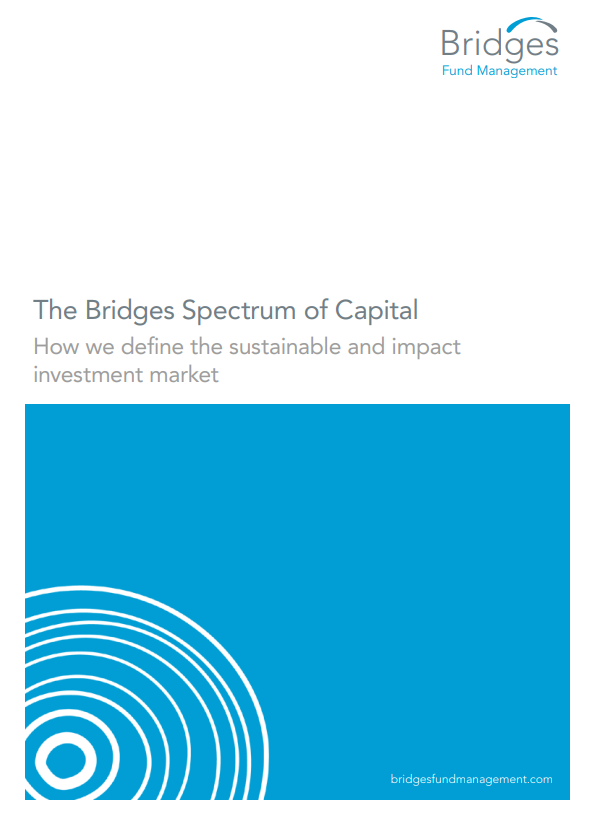Bridges devised a ‘spectrum of capital’, according to which it is possible to design different investment strategies to promote entrepreneurial solutions to societal challenges.
 The idea that investment can be a positive force for societal change is hardly a new one. Ethical or values-based investing arguably dates back centuries, driven primarily by religion. More recently, the changing mores of the 1960s – including the push to eliminate the apartheid regime in South Africa – brought socially-conscious investing to the fore. By the 1980s, Socially Responsible Investing (SRI), which focuses on systematically ‘screening out’ harmful products and practices (such as tobacco or firearms), had a dedicated investor base.
The idea that investment can be a positive force for societal change is hardly a new one. Ethical or values-based investing arguably dates back centuries, driven primarily by religion. More recently, the changing mores of the 1960s – including the push to eliminate the apartheid regime in South Africa – brought socially-conscious investing to the fore. By the 1980s, Socially Responsible Investing (SRI), which focuses on systematically ‘screening out’ harmful products and practices (such as tobacco or firearms), had a dedicated investor base.
Over time, many investors have also recognised that factoring social, environmental and governance risks (ESG) into their investment decisions helps to protect value, particularly in a world of increasing transparency. This has given rise to a broad universe of ‘responsible investors’, ranging from those who ‘negatively screen’ for ESG risks, to those who actively work to mitigate them during ownership. Taking this further, and building upon ‘best in class’ SRI, some investors have deeply integrated social and environmental factors into their investment analysis and started proactively looking for ESG opportunities, selecting companies that they believe will outperform the market because they operate (or have the potential to operate) in a more sustainable way than their peers over time – be it through their environmental management, stakeholder engagement or governance practices. We call this ‘Sustainable Investing’, because it centres on backing businesses that can flourish in a changing landscape – and we distinguish it from Responsible Investing because it focuses not just on protecting value against risk but on creating additional value, through both investment selection and portfolio management. Impact Investing goes beyond this to focus on solutions to pressing societal or environmental issues.
Impact investors focus on one or a cluster of issues, with a deliberate intention to make a positive social or environmental impact. Some want to focus on societal or environmental solutions that can generate market-rate (or market-beating) financial returns. For these investors, there are a growing number of for-profit businesses that help to address a societal or environmental issue through their core product or the place in which they are located. Other impact investors are willing to make investments whose impact thesis may or may not deliver a market-rate financial return – social impact bonds, for example, may produce attractive returns but the product is not yet proven.
A third category includes those who are willing to make investments whose impact approach requires a trade-off of financial return and therefore deliver a below-market financial return. This could, for example, involve backing social business models that re-invest some or all their financial surpluses, such as trading charities, mission-driven cooperatives or cross subsidy models.
All three types of investor intend to create positive change in response to social or environmental issues, and so all are impact investors. Finally, there are funders with an impact-only motivation, who are willing to forgo principal, through philanthropy. These funders continue to play a critical role in in tackling pressing social or environmental issues where commercially viable solutions are not available.
By understanding this spectrum of capital (below), it is possible to design different investment strategies to promote entrepreneurial solutions to societal challenges. As the dotted lines along the spectrum reflect, these categories are not mutually exclusive; often they are interdependent, with many investors operating between or across categories. Bridges Fund Management has specialised in sustainable and impact investing ever since our inception in 2002.
Over this period, we have learned that a variety of business models can create positive impact; so each of Bridges’ funds has been designed to ‘align’ with the needs of a different set of impact-driven business models, and with the financial and impact expectations of different investors. This multi-fund approach is mapped against this spectrum of capital, by way of example. We hope that by illustrating how we have created investment products across this landscape, we might encourage others to explore the growing range of sustainable and impact investment strategies.
End of Preview
